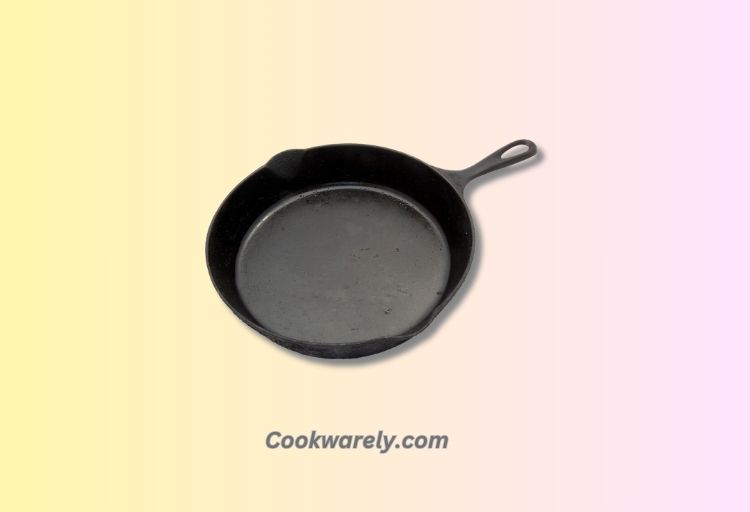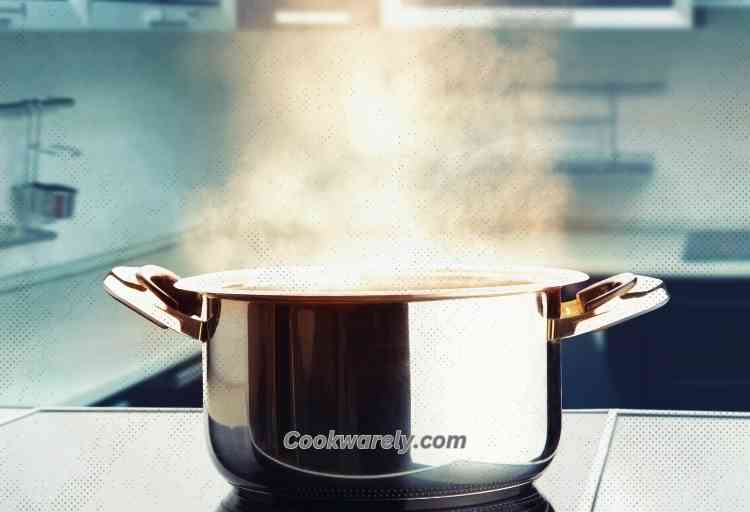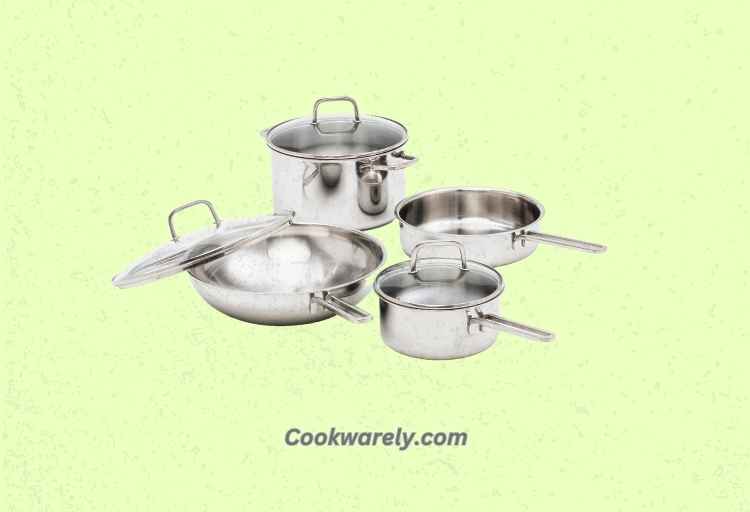What Can You Use Instead Of A Cast Iron Skillet: 10 Alternatives
Alternative options to cast iron skillet, If you don’t have a cast iron skillet, you can use various other options to cook your food evenly and efficiently.
- Tri-ply Stainless-Steel Skillets: Layers of aluminum, copper, and stainless steel ensure even cooking. Ideal for searing and making pan sauces.
- Nickel-Plated Skillets: Pre-coated surface prevents rust, no need for seasoning. Suitable for various recipes, often oven-safe.
- Dutch Ovens: Great for baking, braising, and oven-based dishes. Perfect for soups, stews, roasting, and deep frying.
- Saucepans: Designed for sauces, soups, and soft-textured foods. Not ovenproof, intended for stovetop cooking.

10 Alternatives Of A Cast Iron Skillet
| Alternative to Cast Iron Skillet | Purpose |
|---|---|
| 1. Tri-ply Stainless Steel | Even heat distribution, searing, and sauces. |
| 2. Nickel-Plated Skillets | No seasoning, versatile cooking. |
| 3. Dutch Ovens | Baking, braising, soups, roasting. |
| 4. Saucepans | Making sauces, soups, and soft foods. |
| 5. Pyrex Casserole Dishes | Casseroles, pot roasts, and more. |
| 6. Carbon Steel | Lightweight, seasoning for non-stick. |
| 7. Non-Stick Coating (Teflon) | Easy to clean, ready for use. |
| 8. Ceramic Non-Stick Coating | Durability, no off-gassing concerns. |
| 9. Hard Anodized Aluminum | Even heating, durable non-stick. |
| 10. Copper Skillets | Precise temperature control, gourmet cooking. |
What At-Home Alternatives Can Be Used for a Cast Iron Skillet?
When you don’t have access to a cast iron skillet at home, there are several alternatives you can use for various cooking purposes. Here are some common at-home alternatives:
- Non-Stick Skillets: These are a popular choice and come in various materials like aluminum or stainless steel with a non-stick coating. They are excellent for cooking foods like eggs, pancakes, and delicate items that require minimal sticking.
- Stainless Steel Skillets: Stainless steel skillets are versatile and durable. They are great for searing, browning, and making pan sauces. They offer even heat distribution, although they are not naturally non-stick like cast iron.
- Copper Skillets: Copper skillets are known for precise temperature control. They heat up and cool down quickly, making them suitable for tasks that require precise temperature adjustments, such as cooking delicate sauces.
- Ceramic Non-Stick Skillets: These skillets have a ceramic coating that provides a non-stick surface. They are easy to clean and work well for cooking at lower to medium temperatures.
- Aluminum Skillets: Lightweight and affordable, aluminum skillets heat up quickly and are suitable for various cooking tasks. However, they may not have the same heat retention as cast iron.
- Anodized Aluminum Skillets: These skillets have been treated to make the aluminum surface more durable and non-stick. They are a good alternative for those who want a non-stick option.
- Carbon Steel Skillets: Similar in some ways to cast iron, carbon steel skillets are lighter and require seasoning for a non-stick surface. They are great for high-heat cooking methods like searing.
- Ceramic Cookware: While not exactly a skillet, ceramic pots and pans can be used for various cooking tasks. They are known for even heating and can be used in the oven.
- Glass Baking Dishes: For oven-based recipes, such as casseroles or baked dishes, glass baking dishes like Pyrex are an excellent alternative. They are safe for use in the oven and retain heat well.
- Microwave: For some simple tasks like melting butter or reheating leftovers, the microwave can be a quick alternative.
The choice of alternative depends on the specific dish you plan to cook and your personal preferences. Each of these alternatives has its own set of advantages and considerations, so choose the one that best suits your needs.
How to Effectively Use a Cast Iron Skillet?
Using a cast iron skillet effectively can lead to delicious and perfectly cooked dishes. Here’s a step-by-step guide on how to use a cast iron skillet effectively:
Seasoning (If Required):
- Check the Condition: If your cast iron skillet is brand new or has lost its seasoning, it needs to be seasoned before use. Seasoning creates a non-stick surface and prevents rusting.
- Clean and Dry: Wash the skillet with warm water and mild soap to remove any manufacturing residues. Rinse and thoroughly dry it.
- Apply Oil: Coat the inside of the skillet, including the cooking surface and edges, with a thin layer of vegetable oil or shortening. Make sure to wipe off any excess oil; it should look shiny but not greasy.
- Bake it: Place the skillet upside down in a preheated oven at around 350-400°F (175-200°C). Put a foil-lined baking sheet or foil on the rack below to catch any drips. Bake for about an hour. Let it cool in the oven.
Using Your Cast Iron Skillet:
- Preheat the Skillet: Before cooking, preheat your cast iron skillet on low to medium heat. Cast iron retains heat well, so it doesn’t need high heat settings.
- Add Oil or Fat: Once the skillet is heated, add a small amount of cooking oil or fat to prevent sticking. Spread it evenly across the cooking surface.
- Cooking: Place your food in the skillet. For searing, leave it undisturbed for a few minutes to develop a crust. Avoid overcrowding the skillet, as it can reduce the temperature and affect browning.
- Adjust Heat: Cast iron responds slowly to temperature changes, so you may need to adjust the heat as you cook. Lower heat for gentler cooking or raise it for searing.
- Use Appropriate Utensils: Opt for wooden, silicone, or nylon utensils to avoid scratching the seasoning. Avoid using metal utensils, which can damage the non-stick surface.
- Maintenance During Cooking: If food sticks a bit, gently scrape it with a spatula. This is normal and won’t harm the seasoning.
Cleaning and Maintenance:
- Cool Down: Allow the skillet to cool before cleaning. Avoid placing a hot skillet under cold water, as it can cause it to crack.
- Use Minimal Soap: Use minimal soap and warm water to clean the skillet. Avoid heavy scrubbing, which can remove the seasoning.
- Dry Thoroughly: After washing, dry the skillet immediately with a towel or by placing it on low heat to evaporate any remaining moisture.
- Re-Season as Needed: Over time, the seasoning may wear down. If food starts sticking or the skillet shows signs of rust, it’s time to re-season.
- Store Properly: To prevent rust, store your cast iron skillet in a dry place. You can place a paper towel or cloth inside to absorb moisture.
With proper seasoning and care, your cast iron skillet can become a versatile and long-lasting kitchen tool, providing excellent heat retention and even cooking. It’s ideal for a wide range of recipes, from searing steaks to baking cornbread.
Conclusion
A cast iron skillet can be a remarkable addition to your kitchen arsenal when used effectively. Its versatility and ability to retain and evenly distribute heat make it a valuable tool for various cooking tasks.
Remember to season it properly to maintain its non-stick properties and prevent rust. With the right care and attention, your cast iron skillet can serve you well for generations, providing delicious, well-cooked meals time and time again.
So, don’t hesitate to explore the world of culinary possibilities that a well-maintained cast iron skillet can offer.
TL;DR:
- Season your cast iron skillet for a non-stick surface.
- Preheat on low to medium heat and use minimal oil.
- Proper cleaning and maintenance ensure longevity.
FAQs
What Can I Use Instead Of A Skillet In The Oven
When cooking in the oven, a stainless steel or oven-safe glass baking dish can be used as a substitute for a skillet.
What To Use Instead Of Cast Iron Skillet In Oven
When you need to use something other than a cast iron skillet in the oven, a ceramic or glass baking dish can be a suitable choice.
Cast Iron Skillet Alternative
A suitable alternative to a cast iron skillet is a stainless steel skillet, which offers durability and versatility.
Substitute For Cast Iron Skillet
A great substitute for a cast iron skillet is a carbon steel skillet, providing similar heat retention and seasoning capabilities.
Cast Iron Alternative
An alternative to cast iron cookware is ceramic-coated non-stick cookware, which is easier to maintain and use.
Cast Iron Skillet Replacement
If you need to replace a cast iron skillet, consider a hard-anodized aluminum skillet for excellent heat distribution and durability.
Alternative To Cast Iron Skillet
A reliable alternative to a cast iron skillet is a copper skillet, known for its exceptional heat conductivity.
Cast Iron Substitute
A viable cast iron substitute is a cast aluminum skillet, which is lighter but still offers good heat retention.
Cast Iron Pan Alternative
For an alternative to a cast iron pan, a porcelain-enameled cast iron skillet combines the benefits of cast iron with easy maintenance.
Cast Iron Alternatives
Some cast iron alternatives include carbon steel, stainless steel, and non-stick pans, each with its own advantages.
Alternative To Cast Iron
When seeking an alternative to cast iron, explore options like stainless steel, copper, or carbon steel cookware.
Cast Iron Pan Substitute
A good cast iron pan substitute for baking in the oven is a heavy-duty stainless steel or aluminum baking sheet.
What Can I Use Instead Of Cast Iron
Instead of cast iron, consider using a heavy-duty stainless steel skillet for various cooking tasks.
What To Use Instead Of Cast Iron Skillet
In place of a cast iron skillet, opt for a stainless steel skillet, especially for recipes requiring high heat.
Alternative To Cast Iron Pan
An alternative to a cast iron pan is a hard-anodized aluminum pan, which provides even heating and durability.
Alternatives To Cast Iron
Several alternatives to cast iron cookware include stainless steel, non-stick, and copper pans.
What Can I Use Instead Of Cast Iron Skillet
If you’re out of a cast iron skillet, you can use a stainless steel or aluminum skillet as a suitable replacement.
Can I Use A Dutch Oven Instead Of A Cast Iron Skillet
Yes, you can use a Dutch oven as a substitute for a cast iron skillet in many recipes, as long as it’s oven-safe.
Replacement For Cast Iron Skillet
Consider a heavy-duty stainless steel skillet as a replacement for a cast iron skillet due to its versatility.
What To Use Instead Of A Skillet
In place of a skillet, you can use a sauté pan or a stainless steel frying pan for various cooking tasks.
Cast Iron Skillet Substitute Baking
When baking, a glass or ceramic baking dish is an excellent substitute for a cast iron skillet.
Alternative For Cast Iron Skillet
A suitable alternative for a cast iron skillet is a hard-anodized aluminum skillet, which is durable and offers even heating.
Best Alternative To Cast Iron Skillet
One of the best alternatives to a cast iron skillet is a carbon steel skillet, known for its similar cooking properties.
What Can You Use Instead Of A Skillet
Instead of a skillet, you can use a stainless steel or non-stick frying pan, a sauté pan, or a wok for various cooking needs.




